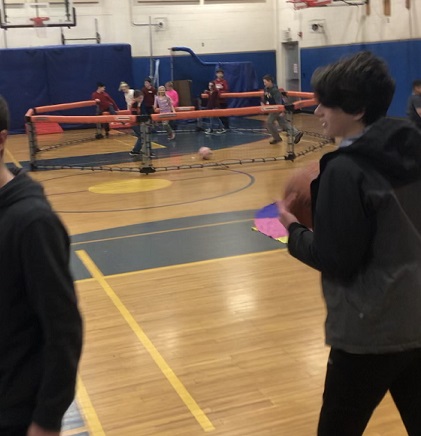The correct way to fundraise

Kids’ Night Out, hosted by the Class of 2022
Ideas and effective methods
Often in high school fundraising is a difficult feat with many fall-backs. There are a lot of clubs competing for money, and the expenses of the clubs often outweigh the fundraising gain. Often, this is because the follow-through factor simply isn’t there. Fundraising effectively isn’t impossible, and doesn’t even have to be difficult! A lot of times the only issue is the method of which a club approaches fundraising, and simple (or not so simple) adjustments can be made to support financial growth.
Methodology
- Make a goal, even better make a goal monthly. A lot of times clubs lack an actual dollar goal. And no, the goal can not be, “make more money.” An exact goal incites more effort on club members’ parts, and actually holds the club accountable when goals are not met.
- Create a plan, (once again) monthly. Depending on how large the monthly goal is, every other month should have one planned larger fundraiser, and one or two smaller supplements. The larger fundraiser should be planned well before the month begins. The supplements are more mobile, you can add some or take them away throughout the month depending how close you are to your club’s dollar goal.
- Create a plan. But this time actually do it. Good job, you have stuff in writing! Bad news, simply talking about something does not wish it into existence. It’s time to hold people accountable. Instead of just saying what needs to be done, assign specific tasks to individuals and record names. Require that individuals email you when they have completed their task, and make sure to set time limits. Larger fundraisers probably need a few people working on a few different tasks (gathering of materials, getting administrative permission, advertising, actual execution of fundraiser, etc.). Supplementary fundraisers only need two or maybe three people working on the whole thing. Think of it as a factory assembly line. Everything will go way smoother when each person has their own task, rather than everyone worrying about everything and arguing.
Deciding what fundraiser to do
- Stay away from selling products through a company. This is okay occasionally, but because our school does so many of these types of fundraisers for class office (pies, candles, etc.), they become less effective. When so many of these types of fundraisers are in circulation, people are less likely to buy much from each, and even may not buy anything at all. To expect someone to buy something they may not even want from a school fundraiser every month, is expecting a lot to say the least. So let’s save these types of fundraisers for when they are needed most, (when students need money for senior trips, and prom fundraising).
- Keep the student body in mind. Fundraisers need to be catered to the CURRENT student body. Often clubs get caught up in fundraisers that actually don’t yield that much money simply because the fundraiser has been put on for years. This is a waste of time and resources.
- Coordinate with other clubs. Overlapping similar fundraisers will hurt all clubs involved. Communication is key, make sure to compromise. Examples include splitting up grades for middle school dances, or even equally collaborating. Recognizing that sometimes, certain clubs may need the money more is also important. Pick and choose your battles, and remember that once an agreement is met, you need to stick to it.
Execution of fundraisers
- Don’t skimp on advertising. Putting together a decent GTV commercial takes 20 minutes if you have a plan, and the commercial doesn’t have to be a work of art. For larger fundraisers make three different commercials so consumers don’t get sick of one constantly playing, and once again cater to the student body. Commercials for larger fundraisers should be a task assigned to two or three people, and completed within three weeks before the fundraiser. Smaller fundraisers probably only need one short commercial, or maybe just a short spoken advertisement on GTV. Smaller fundraiser advertising should be a task assigned to one person.
- Create an incentive. With some fundraisers you can create an incentive for more people to attend. For an example, at a middle school dance you may give each attendee a ticket to put into a raffle for a giveaway item. The giveaway item should be catered to the audience of the fundraiser. Maybe even allow polling so possible attendees can vote on what they think would be a good giveaway item. To create an incentive for pre-ticket sales, say that if you buy a ticket before the date you will receive three raffle tickets for the giveaway instead of one. For larger fundraisers that involve mostly donating, make it a class competition, with a promised party for the winning class.
- Hold people to what they signed up for. If someone signed up to help with the actual execution of the fundraiser, they actually have to show up (duh). If something comes up make sure that it is a common rule that if you can’t make it, you need to find someone to replace you. We wouldn’t want all that hard work you put in to go to waste on the day of the fundraiser because people last minute jump ship.
Larger fundraisers
- Parent’s night out: Parents drop their kids off to do activities while getting a break, this can be combined with a movie night.
- Battle of the bands: I’m not sure how effective this would be in our school since the talent show got canceled last year for lack of participation, but hey you never know! We have some pretty competitive musicians currently attending our school…
- Gently used book sale: I think we’ve done this one before.
- Car wash: Obviously when it’s warmer out. Pretty self-explanatory.
- A variety of middle school dances: These are often highly coveted and fought over, so check to make sure there is no overlap.
- Dog show: When it’s warmer. Galway students sure love their dogs, so give them an opportunity to show them off.
- Debate competition: Except the debate topic is completely random. Put a bunch of silly debate topics in a hat and teams of two have two minutes to come up with an argument and then go through a bunch of rapid debate rounds. The winner wins something.
- Auction: Get items donated to be auctioned off in a sit down dinner style adult event.
- School garage sale: get students and staff to donate unwanted items and put on a giant garage sale!
Supplementary Fundraisers
- Bake sales: Yes it doesn’t yield much money, but $75 once a month isn’t bad for minimal effort. Only two people need to be in charge of executing this if everyone donates one item.
- Snowman building competition: Once again, minimal effort! All that needs to happen is some solid advertising. Students can also vote on “celebrity” judges in the form of teachers.
- Any type of “gram”: This can be edited for literally any holiday. Students pay for a treat to be sent to a friend or significant other on a holiday. Examples include candy on Halloween, flowers or candy on Valentine’s Day, peeps for Easter or spring break, and flowers again for prom season.
- Mini board game tournaments: A different game each month, with a cash prize.
It doesn’t matter what you do, as long as there is actual effort and follow through. If people’s hearts aren’t in it, it simply won’t work. Remember, the fundraiser always has to be something that you think the student body would actually be interested in. I hope this helps your club starts fundraising with noticeable results 🙂

Anna enjoys writing thought provoking articles and is also one half of the "Anna Show". She participates in volleyball, track, robotics, jazz band, GTV,...
